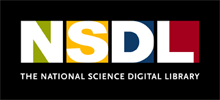
The United States' National Science Digital Library (NSDL) is an open-access online digital library and collaborative network of disciplinary and grade-level focused education providers. NSDL's mission is to provide quality digital learning collections to the science, technology, engineering, and mathematics (STEM) education community, both formal and informal, institutional and individual. NSDL's collections are refined by a network of STEM educational and disciplinary professionals. Their work is based on user data, disciplinary knowledge, and participation in the evolution of digital resources as major elements of effective STEM learning.
United States federal research funders use the term cyberinfrastructure to describe research environments that support advanced data acquisition, data storage, data management, data integration, data mining, data visualization and other computing and information processing services distributed over the Internet beyond the scope of a single institution. In scientific usage, cyberinfrastructure is a technological and sociological solution to the problem of efficiently connecting laboratories, data, computers, and people with the goal of enabling derivation of novel scientific theories and knowledge.
The cancer Biomedical Informatics Grid (caBIG) was a US government program to develop an open-source, open access information network called caGrid for secure data exchange on cancer research. The initiative was developed by the National Cancer Institute and was maintained by the Center for Biomedical Informatics and Information Technology (CBIIT). In 2011 a report on caBIG raised significant questions about effectiveness and oversight, and its budget and scope were significantly trimmed. In May 2012, the National Cancer Informatics Program (NCIP) was created as caBIG's successor program.

European Grid Infrastructure (EGI) is a series of efforts to provide access to high-throughput computing resources across Europe using grid computing techniques. The EGI links centres in different European countries to support international research in many scientific disciplines. Following a series of research projects such as DataGrid and Enabling Grids for E-sciencE, the EGI Foundation was formed in 2010 to sustain the services of EGI.
The National Cancer Research Institute (NCRI) is a UK-wide partnership between cancer research funders, which promotes collaboration in cancer research. Its member organizations work together to maximize the value and benefit of cancer research for the benefit of patients and the public. Rather than replace or duplicate any of the functions of its members, it seeks to add value through joint planning, coordination and collaboration.

The Institute of Museum and Library Services (IMLS) is an independent agency of the United States federal government established in 1996. It is the main source of federal support for libraries and museums within the United States, having the mission to "create strong libraries and museums that connect people with information and ideas." IMLS "works at the national level and in coordination with state and local organizations to sustain heritage, culture, and knowledge; enhance learning and innovation; and support professional development." Their vision is "a democratic society where communities and individuals thrive with broad public access to knowledge, cultural heritage, and lifelong learning." In fiscal year 2015, IMLS had a budget of $228 million.

A smart city is an urban area that uses different types of electronic Internet of things (IoT) sensors to collect data and then use these data to manage assets and resources efficiently. This includes data collected from citizens, devices, and assets that is processed and analyzed to monitor and manage traffic and transportation systems, power plants, water supply networks, waste management, crime detection, information systems, schools, libraries, hospitals, and other community services.
The Australian Partnership for Advanced Computing (APAC) was an Australian organisation established in 1998 to provide advanced computing and grid infrastructure for Australian research communities. APAC was established under the Systemic Infrastructure Initiative objective of the Australian Government's Backing Australia's Ability innovation plan. The Australian National University was the host institution for APAC.
The Research Council of Norway is a Norwegian government agency responsible for awarding grants for research as well as promoting research and science. It also advises the Government in matters related to research, and is subordinate to the Norwegian Ministry of Education and Research. The council's total budget in 2009 amounted to NOK 6 165 million.
Astronomy Australia Limited (AAL) is an independent not-for-profit company whose members are all Australian universities and research organisations with a significant astronomy research capability. AAL's vision is that astronomers in Australia will have access to the best astronomical research infrastructure. The goals of AAL are to engage with Australian astronomers to advance the national infrastructure priorities of the Australian Astronomy Decadal Plan, advise the Government on new astronomy infrastructure investments, and manage infrastructure investments as required.
The New South Wales Land and Property Information , a division of the Department of Finance, Services and Innovation in the government of New South Wales, was the division responsible for land titles, property information, valuation, surveying, and mapping and spatial information in the Australian state of New South Wales. From 1 July 2017, the operation was transferred to Australian Registry Investments, a private consortium, under a 35-year concession with the NSW government. The LPI was subsequently renamed and replaced by the NSW Land Registry Services on 1 December 2017.
Clinical trial registration is the practice of documenting clinical trials before they are performed in order to combat publication bias and selective reporting. Clinical trial registration is required in some countries and is increasingly being standardized. Some top medical journals will only publish the results of trials that have been pre-registered.
GridPP is a collaboration of particle physicists and computer scientists from the United Kingdom and CERN. They manage and maintain a distributed computing grid across the UK with the primary aim of providing resources to particle physicists working on the Large Hadron Collider experiments at CERN. They are funded by the UK's Science and Technology Facilities Council. The collaboration oversees a major computing facility called the Tier1 at the Rutherford Appleton Laboratory (RAL) along with the four Tier 2 organisations of ScotGrid, NorthGrid, SouthGrid and LondonGrid. The Tier 2s are geographically distributed and are composed of computing clusters at multiple institutes.

OER Commons is a freely accessible online library that allows teachers and others to search and discover open educational resources (OER) and other freely available instructional materials.
iVEC was the government-supported high-performance computing national facility located in Perth, Western Australia. iVEC supported researchers in Western Australia and across Australia through the Pawsey Centre and resources across the partner facilities. iVEC was rebranded to the Pawsey Supercomputing Centre in December 2014.
The Pawsey Supercomputing Centre (PSC) is the government-supported high-performance computing national facility located in Perth, Western Australia. Pawsey supports researchers in Western Australia and across Australia through the Pawsey Centre (facility).
The Australian Geoscience Data Cube (AGDC) is an approach to storing, processing and analyzing large collections of earth observation data. The technology is designed to meet challenges of national interest by being agile and flexible with vast amounts of layered grid data.
The NSW Land Registry Services is the business name of Australian Registry Investments (ARI), an operator of land titling and registry operations in the Australian state of New South Wales. It is responsible for the state's land titles, property information, valuation, surveying, and mapping and spatial information. ARI had already taken over the operation of the New South Wales Land and Property Information under a 35-year concession with the Government of New South Wales, as of July 2017. The LPI was renamed to NSW Land Registry Services in December 2017.





